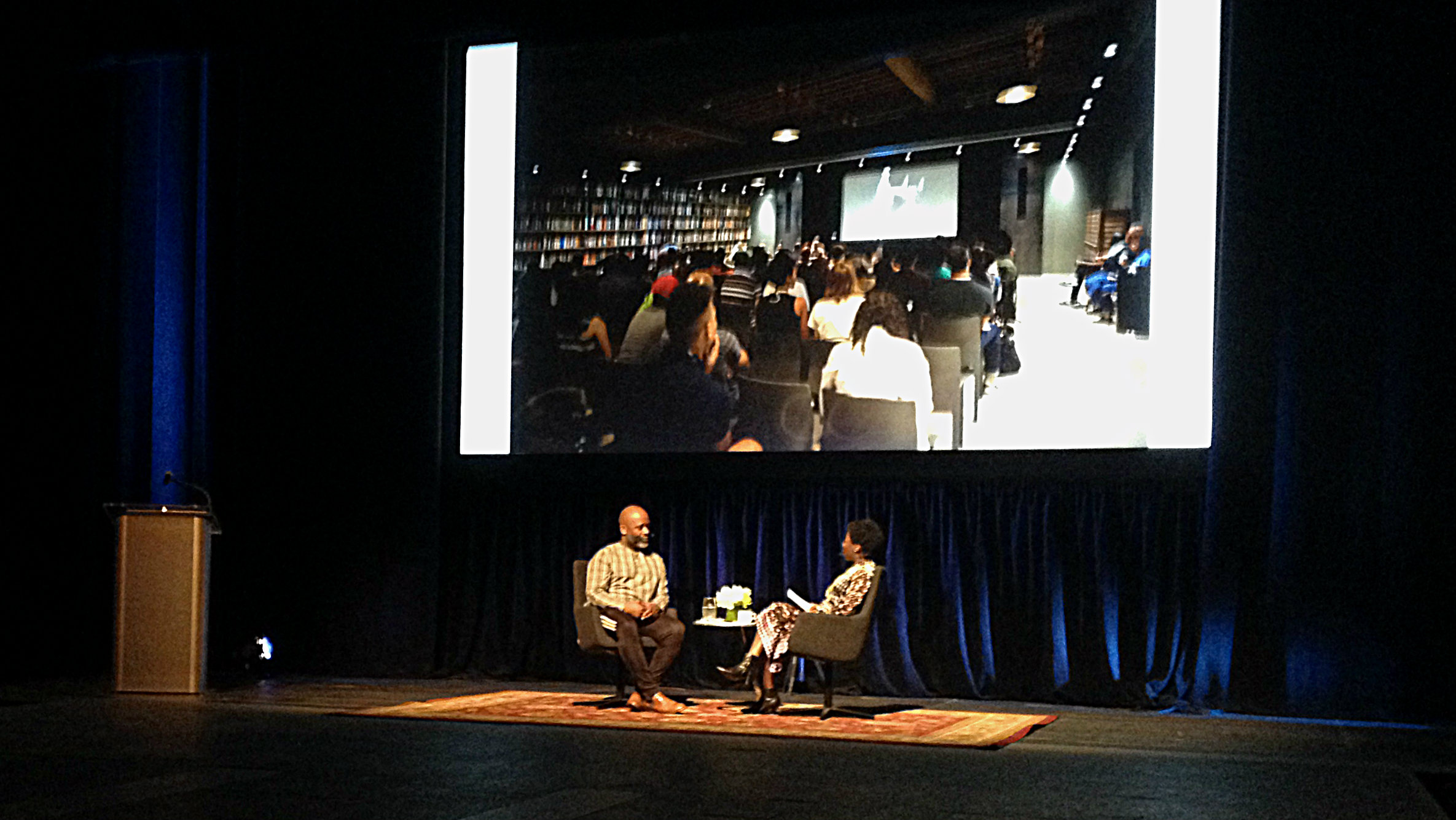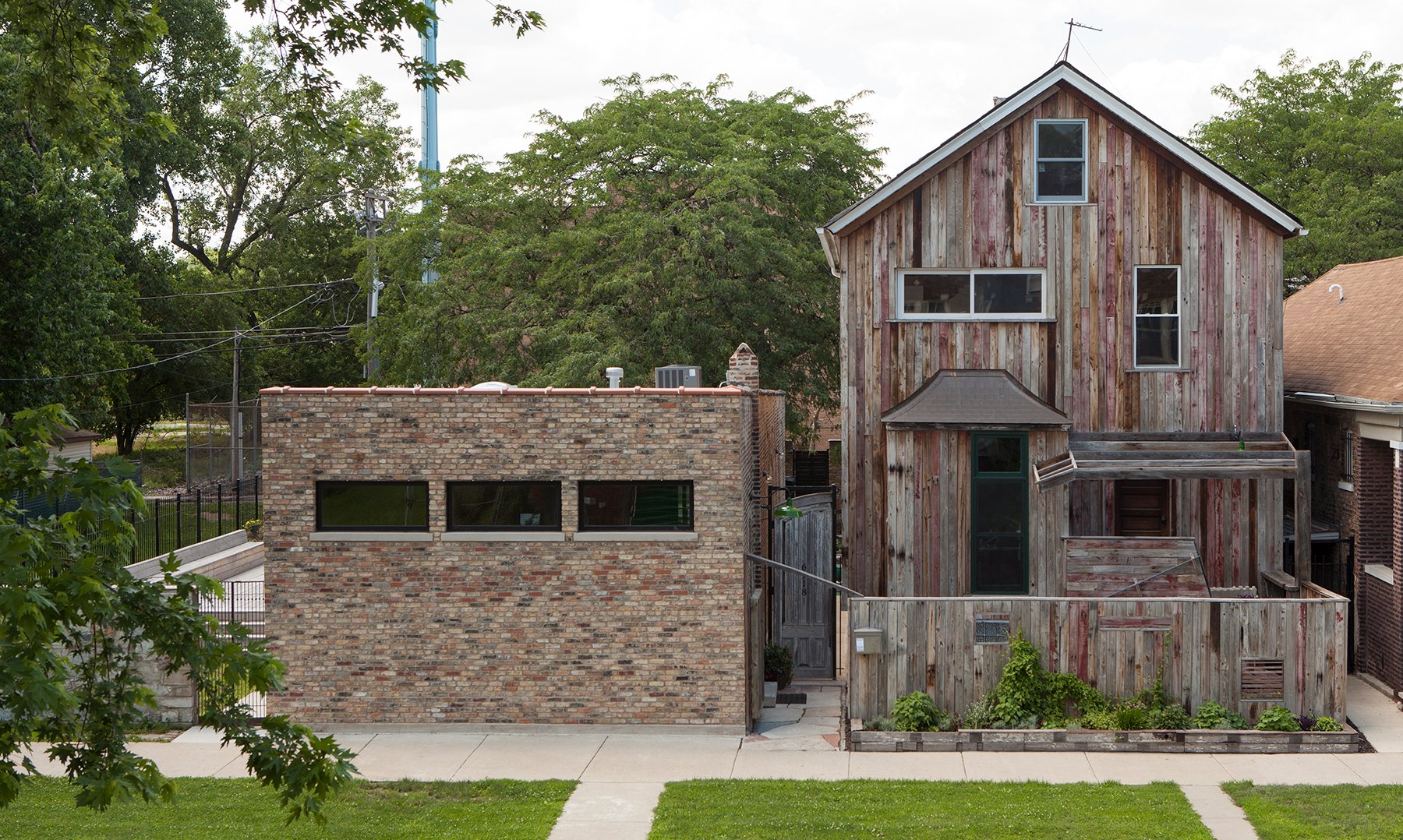Nasher Prize Winner Theaster Gates Causes A Little Ruckus
ArtandSeek.net April 8, 2018 18Over the weekend, Theaster Gates received the Nasher Sculpture Prize, the richest prize in sculpture. Gates is the first American artist and the first African-American to win the $100,000 award. Unlike previous winners, Gates didn’t simply express gratitude or ponder the nature of art, he preached, he inspired, he cracked jokes, he caused a ruckus.

Theaster Gates on stage at the Wyly Theatre with Thelma Golden, the director of the Studio Museum in Harlem. Photo: Jerome Weeks
The Nasher Sculpture Prize doesn’t just come with a fancy awards gala. There are public panels, symposia and a lecture – or in the case of Theaster Gates, a town hall meeting Friday at the Wyly Theatre. At one point, Gates acknowledged the first two Nasher winners: the Frenchman Pierre Huyghe and the Colombian artist Doris Salcedo, who was in the audience. Both had been significant influences on him, and his voice cracked as he said it was hard to express what it meant to join “the greatest living artists in the world.”
Later, he said, through all the onstage interviews and speeches, he just wanted to speak truly – about himself and his art.
“What I wanted more than anything was to say, Even when an opportunity like the Nasher Sculpture Prize presents itself, we have the self-permission to be honest humans.”
Prize winners normally don’t talk like that. But by the time he’d introduced Salcedo, Gates had already drawn laughs and murmurs of agreement and amazement. He was interviewed onstage by Thelma Golden, the director of the Studio Museum in Harlem Citing the work of scholar David Chidester, he outlined African-American traditions of establishing a sacred space, how art can have power, a collective power in establishing such a space and bringing people together. They can share an experience, an experience potentially filled with meaning – historical, spiritual, aesthetic.
“And we do it because it’s as close as we can get to God,” Gates declared, “since we don’t go to church anymore, we don’t experience the Holy Ghost, we don’t eat together on Fridays, all the things that have been the conventions of a collective emotion – we don’t have them anymore. All we have is brunch.” The audience laughed.
Gates dismissed the modern notion of appreciating an art object solely as freestanding and separate. It’s supposedly devoid of any sense of how it was created, the people who built the object, what they were paid, where its materials came from.

At the Nasher gala, Theaster Gates and UNT professor and artist Annette Lawrence. Photo: Jerome Weeks
That’s the mentality of the marketplace, Gates said. Sculpture, he insisted, is bigger than that.
“That’s a false, shortened truth,” he declared. “If there was a way we could understand the object relative to all the other mechanics, we might understand the world.”
Shay Youngblood, a Denton-based artist and author, said Gates’ performance was unlike any arts lecture or stage interview she’d witnessed: “He blew the top of my head off. He articulated so beautifully what it means to be an artist.”
Gates has created conventional and unconventional sculptures drawing on black history, African belief systems and personal experience. One of his smaller pieces looks like a church steeple made of white clay. But it also resembles the white hood of a Klansmen. He’s used tar in some works to represent blackness – but also as a connection to his father, who worked as a roofer.
Gates has gained international attention because in an impoverished area of Chicago’s South Side, he’s been reclaiming a black neighborhood that was left to rot. He’s bought up old homes, even an empty bank. He’s turned them into public centers, galleries. He’s built artist townhomes.
But this fusion of art and community activism is often labeled ‘social practice’ or ‘social sculpture.’ And Gates has little use for the term.
“Social sculpture,” he said, “is ‘sculpture’ with an extra word because art historians needed jobs.”

Theaster Gates’ Dorchester Projects
But in the second half of the town hall, North Texas artists came prepared to ask Gates questions – often about social practice, about including the community in the urban renewal he’s created. Giovanni Valderas is a Dallas artist who’s been protesting the gentrification of his Oak Cliff neighborhood by setting out pinatas shaped like sad little houses at construction sites.
“If an artist is not considering social practice in their work,” Valderas asked, “isn’t the artist acting in the same way as a developer in order to spur gentrification?
Gates replied he was the one who saw the potential of a neighborhood close to downtown and mass transit. He approached black investors, they weren’t interested. They wanted to bank on winners, and the South Side didn’t look like one. Now, Gates has re-purposed some 80 buildings. And plans on more.
“I created that value!” Gates yells. “And the value was already there. It was latent. There were already brilliant people there. There was already amazing architecture there. I saw it! If you want to stop gentrification, you’ve got to have a deed. How about we put our money together and buy a building? You want to stop gentrification, buy a building!”
The next day, at the awards gala, Gates says his objection is more to the term ‘social sculpture’ than anything else.
“Sculpture has always been social, it’s always been material, it’s always been spiritual. Those things are already unified, and I don’t need extra labels for them. But what I wanted more than anything else to say was, even when an opportunity like the Nasher Sculpture Prize presents itself, we have the self-permission to be honest humans.”
Jeremy Strick is the director of the Nasher Sculpture Center. He says at issue for Gates is mostly just finding the label ‘social practice’ or ‘social sculpture’ confining.
“He has been labeled for some time a social practice artist, and that’s a label he’s been increasingly uncomfortable with. I don’t think he wants to be constrained by any label. He understands himself as an artist, period, and doesn’t want the modifier.”
Then it’s completely in keeping with Gates’ thinking, and his desire to find value in old things, that he’s already used the Nasher Sculpture Prize money … for not exactly sculpture. Before he got into clay-making full-time, Gates used to perform spoken-word poetry. So now he’s bought an antique printing press. He plans on establishing a line of poetry books – including his own.









